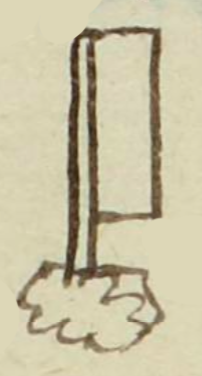Cepayauh (MH777v)
This black-line drawing of the compound glyph for the personal name Cepayauh ("Snow" or "It Has Snowed") is attested here as a man's name. The glyph shows either a small pile of white snow or a cloud (suggesting weather, which could include the verb "to snow," cepayahui). The vertical flag (panitl) is here as a phonetic indicator of the "-pa-" in the middle of the name.
Stephanie Wood
A similarly-shaped cloud in the Codex Mendoza (colored orange) seems to refer to hail or snow (translated as tequizqui). The Telleriano-Remensis shows snow falling in a big dotted cloud, which may be either tequizqui, if hard, or cepayahuitl, if frozen rain. See these examples below.
Stephanie Wood
antoo. cepayauh.
Antonio Cepayauh
Stephanie Wood
1560
Jeff Haskett-Wood
cepayahuitl, nevar, nieve, nubes, banderas, nombres de hombres, clima, tiempo, fonetismo

cepayahui(tl), snow, https://nahuatl.wired-humanities.org/content/cepayahuitl
Nieve, o posiblemente Ha Nevado
Stephanie Wood
Matrícula de Huexotzinco, folio 777v, World Digital Library, https://www.loc.gov/resource/gdcwdl.wdl_15282/?sp=629&st=image
This manuscript is hosted by the Library of Congress and the World Digital Library; used here with the Creative Commons, “Attribution-NonCommercial-ShareAlike 3.0 License” (CC-BY-NC-SAq 3.0).


